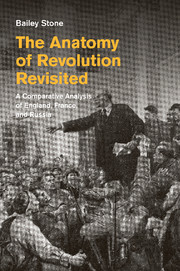‘Despite covering an enormous and highly contentious historiography for these revolutions, and covering hundreds of years of history, this book is deft, clear, and a good read. Bailey Stone is particularly good at working with the international, religious/nationalist, and social forces behind every twist and turn of the detailed events. There is nothing else quite like it for telling the story of these three major revolutions in a comparative framework. This is an outstanding book, a worthy sequel to Crane Brinton.’
Jack A. Goldstone - Virginia E. and John T. Hazel, Jr, Professor of Public Policy and Eminent Scholar, George Mason University
‘The Anatomy of Revolution Revisited is an ambitious effort to chart and analyze three major revolutions that defined the meaning of ‘revolution’ in the European political tradition. However, the purpose of the book is not to evince a standard model for the revolutionary process, nor is it to apply a ready-made one to the three upheavals under examination. Rather, as a work of comparative history, the book tells the ‘story’ of each revolution largely on its own terms. A thoughtful, sophisticated, and illuminating comparative study of three European revolutions that helped form the modern world, this book is a worthy successor to Crane Brinton’s classic, Anatomy of Revolution.’
Thomas Kaiser - University of Arkansas, Little Rock
'Stone’s book is a brilliant tour de force, certain to prove of interest to many readers. Needless to say, it should have a place in every serious university library.'
Sabrina P. Ramet
Source: Europe-Asia Studies
'As its title suggests, this book seeks to offer a comparative analysis of the three great revolutions in European history - the English (1640–60), the French (1789–99), and the Russian (1917–29), revisiting themes first explored by Crane Brinton in his Anatomy of Revolution of 1938. … There is much to admire here, and throughout the author makes a powerful case for the importance of comparative history.'
Tim Harris
Source: Journal of Modern History





